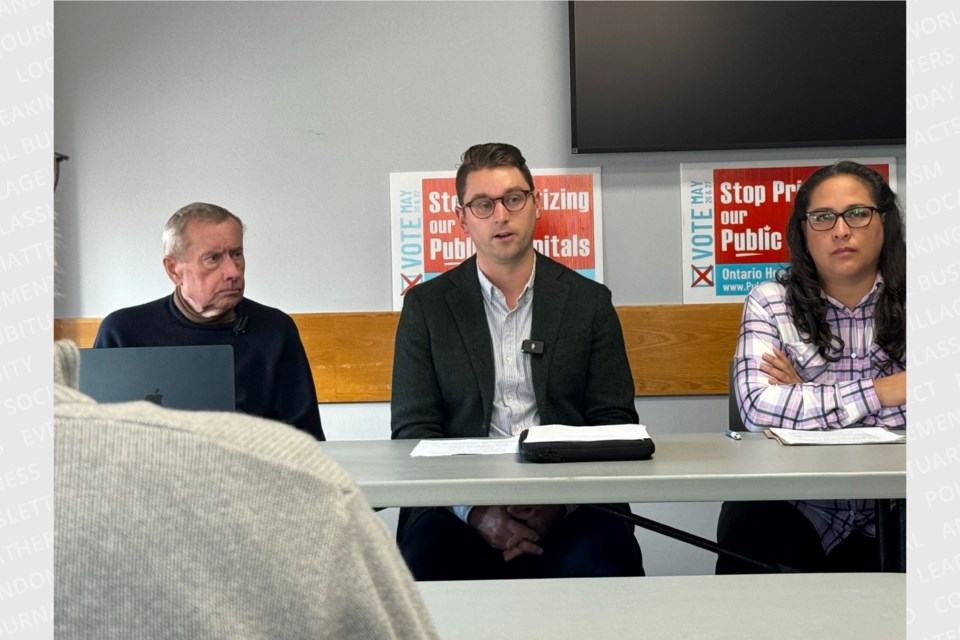Local health-care professionals gathered Thursday afternoon to hear the findings of a new report calling on the Ontario government to scrap its plans for the expansion of for-profit health care.
Andrew Longhurst — a political economist, PhD candidate, and Simon Fraser University research associate — presented the findings of the report, titled At What Cost? Ontario Hospital Privatization and the Threat to Public Health Care, during a news conference at the downtown Barrie Public Library branch.
The report, published by the Canadian Centre for Policy Alternatives, looks at policy and legislative reforms used to expand for-profit delivery of surgical and diagnostic imaging in Ontario. It also looks at Ontario’s wait-time performance in relation to other provinces, as well as a financial accounting of how for-profit dollars have been spent in for-profit facilities, explained Longhurst.
Details contained in the report were gathered using public information and freedom of information requests.
“In August 2022, the Ontario government announced that it would increase the number of publicly funded surgeries and diagnostic procedures performed in for-profit facilities. The use of public funds to perform procedures in for-profit facilities is called outsourcing, contracting out, or simply for-profit delivery, and this is a form of health-care privatization,” he said.
What the research report points out, Longhurst said, is “especially puzzling and troubling” that the province is moving in this direction when it has much shorter wait times compared to provinces that currently have the greatest number of for-profit delivery of service.
“This is not to say that wait times are anywhere near where they should be in Ontario," he said. "There is a lot of work to be done and this report identifies how the province can do that through an evidence-based strategy, but it’s especially troubling the Ontario government is moving in this direction when we see quite clearly that in many areas, including hip and knee replacements and CT and MRI scans … Ontario performs the best in the country.”
With staffing shortages being the worst they have ever been, the expansion of private health-care facilities will only exacerbate that situation and can “destabilize” public hospitals.
“The issue is we have a workforce that can’t be in two places at once … you’re pulling on that same limited pool of staff and they have to come from somewhere, and they come from the public hospital system,” Longhurst said.
The report rebuts the government’s rationale for privatization by showing sufficient funding for public hospitals can significantly improve surgical backlogs. In Barrie, he points out, operating rooms often are not used in the evenings or on weekends.
“Ontarians have already paid for this infrastructure. We don’t need to pay investors a premium to build these facilities. We have the operating theatres already in this province, but what we need is the commitment for funding and increased staffing,” he said.
Anisa Carrascal, co-chair of the Simcoe County Health Coalition, said the group has been compiling information from regional health-care centres, and has found all are “severely short staffed.”
“The money announced by the Ministry of Health is but a drop in the bucket of what is really needed. The capacity of our county to respond to emergencies is diminishing rapidly with no end in sight,” she said. “All five hospitals in Simcoe County have posted public warnings of ERs experiencing extended wait times more than a dozen times since July. Some went so far as to post on their social media accounts, directing people to virtual health services that are not covered by OHIP. This is the point we’ve reached here … is that you cannot access your ER services.”
Simcoe County has plenty of room to improve on health-care services, she continued, noting local hospitals have the space to conduct surgeries and diagnostic services. What is lacking is the staff to perform the surgeries.
“The problem will be even worse when (staff) leave public hospitals to go work in private clinics, which is already happening,” said Carrascal. “The poaching has already started.”
Longhurst said it’s important not to get lost in the “pizzazz” that may come with services at private facilities.
“What matters is staffing levels, staffing mix, and access to professionals and the ability for patients to get the care that they need,” he said.



